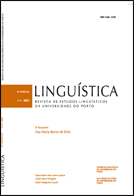Language evolution and natural order of words: reversible and non-reversible verbs in São Tomé and Príncipe Sign Language in a pilot study
Abstract
Research on language evolution has recently focused on the issue of natural word order, that is, word order in the phylogenetic and cognitive sense (Pagel 2009; Gell-Mann and Ruhlen 2011). Sign language and gesture studies have inspired this discussion in the literature, with special emphasis on the seminal study by Goldin-Meadow and colleagues (2008). The results of this study revealed that participants tend to produce SVO and SOV word order, regardless of the syntax of their native language. This finding has been corroborated in later studies (Gibson et al. 2013; Hall et al. 2013; Sandler et al. 2005). Our study aims to verify if there is dominant word order, or not, in linguistic emergence of Sign Language of São Tomé and Príncipe.
References
Bengtson, J. D. & Ruhlen, M. 1994. Global etymologies. In: M. Ruhlen (Ed.). On the origin of languages: Studies in linguistic taxonomy. Stanford: Stanford University Press, 277–336
Bickerton, D. (1990). Language & species. Chicago-London: University of Chicago Press.
Boruta, M. & Placiński, M. 2017. The syntax in pantomimic re-enactments of events among Polish participants. Culture and Education Journal, 2(116): 106–118
Gell-Mann, M. & Ruhlen, M. 2011. The origin and evolution of word order. Proceedings of the National Academy of Sciences, 108(42): 17290–17295.
Gibson, E., Piantadosi, S. T., Brink, K., Bergen, L., Lim, E. & Saxe, R. 2013. A noisychannel account of crosslinguistic word-order variation. Psychological Science, 24(7), 1079–1088.
Goldin-Meadow, S. & Feldman, H. 1977. The development of language-like communication without a language model. Science, 197(4301): 401–403.
Goldin-Meadow, S., So, W.C., Özyürek, A. & Mylander, C. 2008. The natural order of events: How speakers of different languages represent events nonverbally. Proceedings of the National Academy of Sciences, 105(27): 9163–9168.
Hall, M. L., Mayberry, R. I. & Ferreira, V. S. 2013. Cognitive constraints on constituent order: Evidence from elicited pantomime. Cognition, 129(1): 1–17.
Hock, H. H. 2015. Proto-Indo-European verb-finality: Reconstruction, typology, validation. In: L. Kulikov & N. Lavidas (eds.) Proto-Indo-European Syntax and its Development. Benjamins Current Topics, 75: 51–78.
Jackendoff, R. & Wittenberg, E. 2017. Linear grammar as a possible steppingstone in the evolution of language. Psychonomic Bulletin & Review, 24(1): 219–224.
Mineiro A. Báez-Montero I. C., Moita M, Galhano-Rodrigues I., & Castro-Caldas A. 2021. Disentangling Pantomime From Early Sign in a New Sign Language: Window Into Language Evolution Research. Front. Psychol. 12: 640057. doi: 10.3389/fpsyg.2021.640057.
Mineiro, A. 2020. Ensaio sobre génese e evolução da linguagem na espécie humana. Entre o gesto, a fala e a escrita. Mauritius: Novas Edicões Acadêmicas.
Mineiro, A. Carmo, P. Caroça, C. Moita, M. Carvalho, S. Paço, J., et al. 2017. Emerging linguistic features of Sao Tome and Principe Sign Language. Sign Lang. Linguist. 20: 109-128, doi: 10.1075/sll.20
Mineiro, A. Carmo, P. 2016. Língua Gestual de São Tomé e Príncipe: retrato dos primeiros gestos. Revista de Estudos Linguísticos da Universidade do Porto, Vol.11, Porto: 161-182.
Pagel, M. 2009. Human language as a culturally transmitted replicator. Nature Reviews. Genetics, 10(6): 405.
Sandler, W., Meir, I., Padden, C. & Aronoff, M. 2005. The emergence of grammar: Systematic structure in a new language. Proceedings of the National Academy of Sciences, 102(7): 2661–2665.
Senghas, A., Kita, S. & Özyürek, A. 2004. Children creating core properties of language: Evidence from an emerging sign language in Nicaragua. Science, 305(5691): 1779–1782. doi: 10.1126/science.1100199
Zywiczzynski, P. Wacewicz, S. Sibiershka, M. 2018. Defining Pantomime for Language Evolution Research, Topoi, 37: 307-318.
Żywiczyński P. Wacewicz S. Lister C. 2021 Pantomimic fossils in modern human communication. Philosophical transactions of the Royal Society of London. Series B, Biological sciences, 376: 20200204. https://doi.org/10.1098/rstb.2020.0204.
Downloads
Published
Issue
Section
License
Copyright (c) 2021 Linguística: Revista de Estudos Linguísticos da Universidade do Porto

This work is licensed under a Creative Commons Attribution-NonCommercial 4.0 International License.



